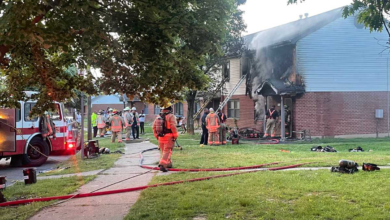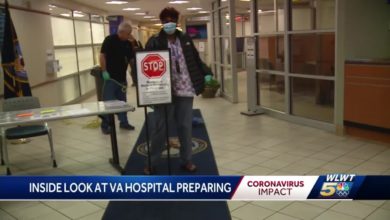
NEW YORK CITY — A fire in a Bronx high-rise that killed 17 people and injured dozens more is prompting questions about how toxic smoke moved unabated through the building and renewing calls for congressional approval of fire-safety legislation for older public housing and aging high-rise buildings.
Residents of the 19-story building without fire escapes or sprinklers found themselves trapped on the upper floors as smoke moved through stairwells and hallways, where self-closing doors were supposed to have blocked the fire's spread.
A 2018 law was intended to prevent such a tragedy. After an apartment building fire in the Bronx killed 13 people in 2017, city leaders passed a law requiring self-closing doors that open into corridors or stairways for apartment buildings, hotels, nursing homes and other multiple-dwelling units. Owners were required to install such doors as of July 2021.
The Twin Parks North West complex was up to code and had self-closing doors, property owners say. Maintenance staff repaired the lock on the fire unit's entry door in early July in response to a work order request, and no other issues had since been reported to property management, Kelly Magee, a spokesperson for the building's owner, Bronx Park Phase III Preservation LLC, said Monday.
US RESIDENTIAL FIRES HAVE DECLINED OVER THE DECADES:Bronx blaze is a reminder how dangerous they can be.
But, Sunday, the door "malfunctioned" as a family left their apartment to flee the fire, Fire Commissioner Daniel Nigro said in a press conference Monday. The fire "started in a malfunctioning electric space heater" in a bedroom of a duplex apartment on the second and third floors of the building, he said.
"As they left, they opened the door, and the door stayed open," Nigro said.
Self-closing door violations were issued to Twin Parks North West in 2017 and 2019, the New York City Department of Housing Preservation and Development said. The violations were corrected by 2020, and no self-closing door violations have since been issued to the complex, the department said.
Citywide, the department said it issued over 22,000 self-closing door violations in the 2021 fiscal year, and more than 18,000 of those violations were corrected.
"Yesterday's fire was a devastating tragedy, and our hearts go out to all the families affected by the worst kind of loss," the department said in a statement. "We urge residents to report malfunctioning doors to property owners or call 311 if issues are not corrected and HPD will respond.”

Karen Dejesus, 54, an 18-year resident of the building, told USA TODAY her doors didn’t close automatically. She said she didn’t know if any of the doors did.
Dejesus said the fire alarms in the building went off so regularly that it was like "second nature to us." But when she started to see the smoke and heard people yelling for help, she realized the fire was real.
Other residents echoed Dejesus' account. Many told multiple news outlets the building had a faulty fire alarm system that often went off unprompted, causing many to initially believe Sunday's alert was another false alarm.
Magee said there were no known issues with the smoke alarms and that residents smoking in the stairwells have previously tripped the alarms.
It was not immediately clear if the building violates fire codes. Forensic engineers with the New York City Department of Buildings were on the site investigating the incident and determining whether the structure meets applicable code requirements, Andrew Rudansky, a department spokesperson, said.
'TRAPPED':Bronx apartment resident recalls harrowing escape from deadly fire
The 120-unit high-rise built in the early 1970s has had numerous violations, including complaints about a malfunctioning elevator, and all but two have been resolved, city records show. The heat in the building worked, but some units are drafty, Dejesus said.
In Monday's press conference, New York City Mayor Eric Adams said the building had "no outstanding violations" for complaints related to lack of heat.
The building does not have fire escapes, which were phased out for new construction in the city's 1968 Building Code.
Complying with current building codes, the Bronx high-rise's compactor and laundry room have sprinklers, and the building is considered non-combustible, meaning it has concrete-poured ceilings and floors, in addition to 90-minute-rated fire doors, in accordance with regulations, Magee said.
That's not sufficient, said Shane Ray, president of the National Fire Sprinkler Association, a Maryland-based tax-exempt organization. Many older public housing and aging high-rise structures typically were built decades ago, before fire sprinklers were required, and installing sprinklers would help save lives, he said.

"Fire’s fast, but fire sprinklers are faster. They save lives," Ray said Monday.
Even buildings largely made of concrete and other non-combustible material still pose fire risks to residents, visitors and firefighters, he said.
"What kills occupants and firefighters most of the time" is dangerous smoke from TVs, couches, beds and other building contents consumed by fires, said Ray.
Following the Bronx fire and a similar fire in Philadelphia last week that killed 12 people, Ray's organization, along with the International Association of Fire Fighters, the National Fallen Fire Fighter Foundation, the International Association of Fire Chiefs, and the National Association of State Fire Marshals, issued a statement calling for congressional action on national fire-safety legislation.
Pending congressional funding measures could help pay the cost, likely hundreds of millions of dollars or more, Ray said. The U.S. Department of Housing and Urban development alone has estimated that roughly 570,000 of the agency’s public housing units were built before sprinklers were required, he said.
FACT? CHECKED:Get the truth with USA TODAY’s free Checking the Facts newsletter
The Biden administration’s stalled Build Back Better legislation includes approximately $53 million for safety features in public housing, including sprinkler retrofits, Ray said.
Additionally, legislation introduced in the House and Senate last month would provide tax incentives for owners of privately-owned buildings like the one in the Bronx to install sprinklers, he said.
Asked how many residential buildings taller than 100 feet have sprinklers, Rudansky, the New York City Department of Buildings spokesperson, said the department does not have that data.
In a statement Monday, New York City Council Member Carlina Rivera, who sits on the city's Committee on Housing and Buildings, called on local authorities to address the "root causes" of the disaster.
"The onus fully lies with building management's failure to comply with legal requirements, from functional ventilation, sprinkler, and alarm systems to self-closing doors to adequate and reliable heating," Rivera said. "It is clear that there is a critical breakdown in the chain of command when it comes to oversight of our City's residential buildings, and tenants – our family, friends, and neighbors – are the victims of this negligence."
Source link










